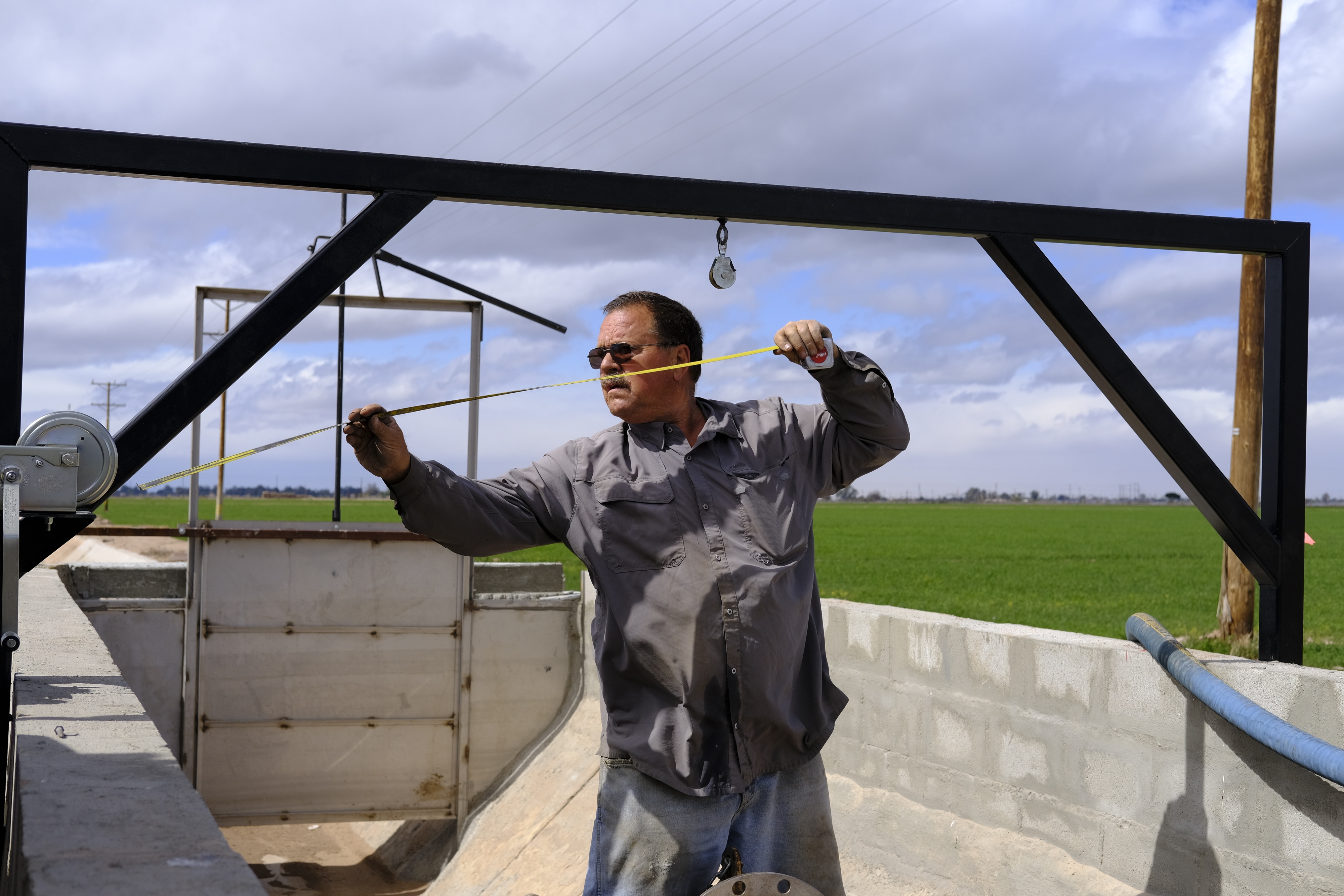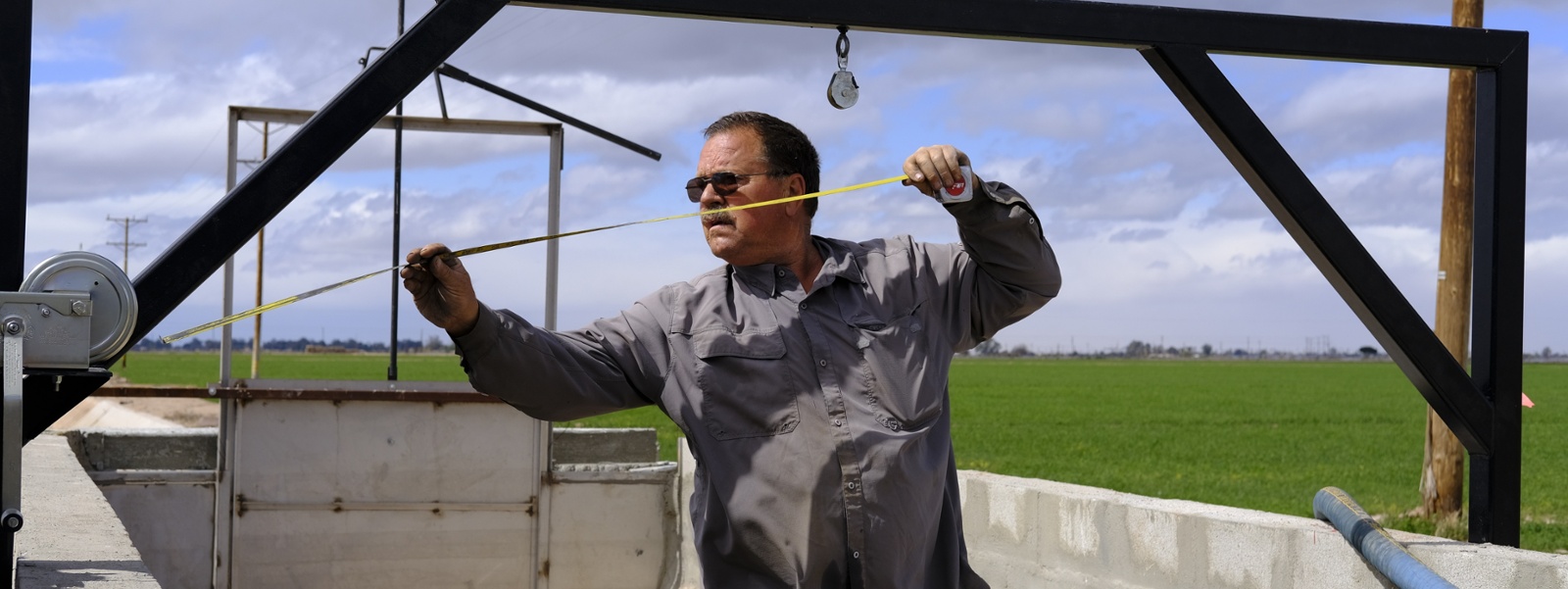Facing cuts, farmers step up on water conservation


Ronnie Leimgruber and other Imperial County farmers have worked for years to make their irrigation systems as efficient as possible. With farms in the valley set to take on steep water cuts under California’s proposal to address the Colorado River crisis, farmers are making financial investments in additional water-conservation projects to avoid fallowing fields in the important agricultural region.
By Caleb Hampton
On a blustery day early this month, Imperial Valley farmer Ronnie Leimgruber climbed into an irrigation ditch between fields of alfalfa, taking measurements and applying a sealant to the threaded pipes of a water pump. The pump delivers water to a hose-drag irrigation system, a field-length structure with dozens of hoses that is designed to conserve water when irrigating crops.
Amid warnings the Colorado River is running dry, farmers across the Imperial Valley are working to transform their irrigation infrastructure and save water. These farmers hold senior rights to more than a third of all the water in the river’s Lower Basin. And under California’s plan for cutting its use of Colorado River water, they are set to shoulder most of the burden.
This month, workers across the valley laid out sprinkler pipe, laser-guided machines leveled fields, pumps recycled water and hoses hung from the sky. These projects, while essential to future efficiency, are part of a decades-long effort by farmers in the region to conserve water.
Since 1988, the Imperial Irrigation District, which manages the valley’s collective water rights, has transferred water to cities in Southern California. “We are conserving a heck of a lot of water already,” said Tina Shields, the IID’s water manager.
In 2003, facing pressure from the George W. Bush administration, the IID approved the nation’s largest agriculture-to-urban water transfer. Altogether, the Imperial Valley sends nearly one-fifth of its entitlement each year to San Diego, Los Angeles and Coachella. In exchange, urban water agencies pay the IID to fund water-conservation projects on Imperial Valley farms.
“We’ve all had the understanding that water is going to be a diminished resource going down the road,” said Mark McBroom, who chairs the IID’s Agricultural Water Advisory Committee and grows citrus fruit, dates, alfalfa and other crops.
To get from the Colorado River to Imperial Valley farms, water flows through the largest gravity-fed irrigation system in the Western hemisphere, traveling through the All-American Canal and into smaller channels and ditches that run between fields spanning nearly half a million acres. Traditionally, farmers in the valley irrigated many crops by opening a gate on one end and allowing water to flood across sloped fields before draining off the other end.
To maximize efficiency, some farmers are using methods to apply water more judiciously while others have set up systems to recycle it. “I deal with the problem at the beginning,” Leimgruber said. The mobile hose-drag machines irrigate his alfalfa and other crops with hoses that hang near the surface of the crop, minimizing evaporation loss and runoff.
There are many other strategies. Early this month, in a field west of Calexico, workers poured concrete into irrigation ditches to reduce seepage and used laser technology to level the field. The precision-leveling project is expected to save around 3 acre-feet of water per year by smoothing out the surface the water runs across, said farmer Tom Brundy.
Growers are also building systems to reuse the runoff from flood irrigation. Mark Osterkamp, who grows carrots, onions, alfalfa and other crops, is installing tailwater recovery systems on about half the acreage he owns. The systems “capture water and pump it back to the headland,” Osterkamp said. He estimates the systems reduce his water use on those fields by up to a quarter.
Over the past two decades, the IID and farmers have spent over $500 million in on-farm conservation projects, saving millions of acre-feet of water and helping farmers install efficient infrastructure on many fields.
But to save more water, as they now must, farmers face steeper obstacles. “The low-hanging fruit that was most cost-efficient has already been done,” said Larry Cox, another Imperial Valley farmer. “If we want to conserve more water, it’s going to come at a higher cost.”
Tailwater recovery systems, for instance, require an expensive pump and either diesel or access to an industrial power line. So far, the systems have mostly been installed where farmers have adjacent fields that can be served by a single pump and a nearby power line. “We were fortunate that most of our land is contiguous,” said Osterkamp. “Most farmers have fields that are separated from other fields.”
At this point, expanding the water-recycling systems will require extending power lines or spending large sums on diesel, in many cases to serve smaller plots. Other conservation methods bring similar challenges, which are compounded by the high cost of fuel, labor and materials. “Our cost of conserving water has risen markedly the last few years,” Cox said.
Under ideal circumstances, farmers, who invest their own money and get reimbursed later, can turn a profit on some of the projects, but they can also lose money. “It’s not a cash windfall,” McBroom said.
Leimgruber has received about $10 million in funding for water conservation and spent $3 million of his own money. “There’s no way in hell I’ll ever see a penny of return on that investment,” he said.
Brundy has used his own cash on precision-leveling and other conservation efforts. “This is what a lot of farmers are doing on their own dime,” he said.
Until now, funding for on-farm conservation projects has mostly come from California water agencies, though federal funding was recently approved. “We really have to throw money at the program so farmers can afford to do the more expensive infrastructure-type projects,” Shields said.
The Inflation Reduction Act includes $4 billion for Colorado River drought relief. Some of the funds could be used to install water-conservation infrastructure or to pay farmers to fallow their fields—a last resort most farmers hope to avoid.
“We want to keep the Imperial Valley and its economy strong,” Osterkamp said. He pointed out that contrary to fallowing fields, funding water-efficiency projects in the Imperial Valley brings additional jobs to one of California’s poorest counties.
But given the scale of the promised water cuts, some fallowing is likely. McBroom is already sacrificing some of his alfalfa to keep his citrus trees alive. “I have the fields just sitting idle,” he said.
Last year, the U.S. Bureau of Reclamation forecast that Imperial Valley farmers were on track to exceed their annual water cap, prompting some growers to dry up their fields midseason. The Imperial County Farm Bureau estimated growers suffered more than $50 million in crop losses.
Going forward, “If they’re not farming or they’re farming less, they need to be made whole, and the community needs to be made whole,” Shields said.
The farmers are adamant they still have a right to their full entitlement of Colorado River water, a more senior right than everyone but a few tribes. Growers such as Leimgruber have agreed to forfeit some of it—temprarily and for compensation—to keep water flowing in the river in hopes of preserving a farming future in the Imperial Valley.
“My grandfather came here and spent every dime he had developing the ground and the irrigation system,” he said. “I spend every dime I have to develop the ground and develop the irrigation system. I want my grandkids to have the opportunity I had.”
(Caleb Hampton is an assistant editor of Ag Alert. He may be contacted at champton@cfbf.com.)
Read the series:
Part 1
Colorado River crisis tests a proud region
Facing cuts, farmers step up on water conservation
Part 2
Desert farmers defend maligned alfalfa production
Part 3
As river runs dry, desert region is at a crossroads




